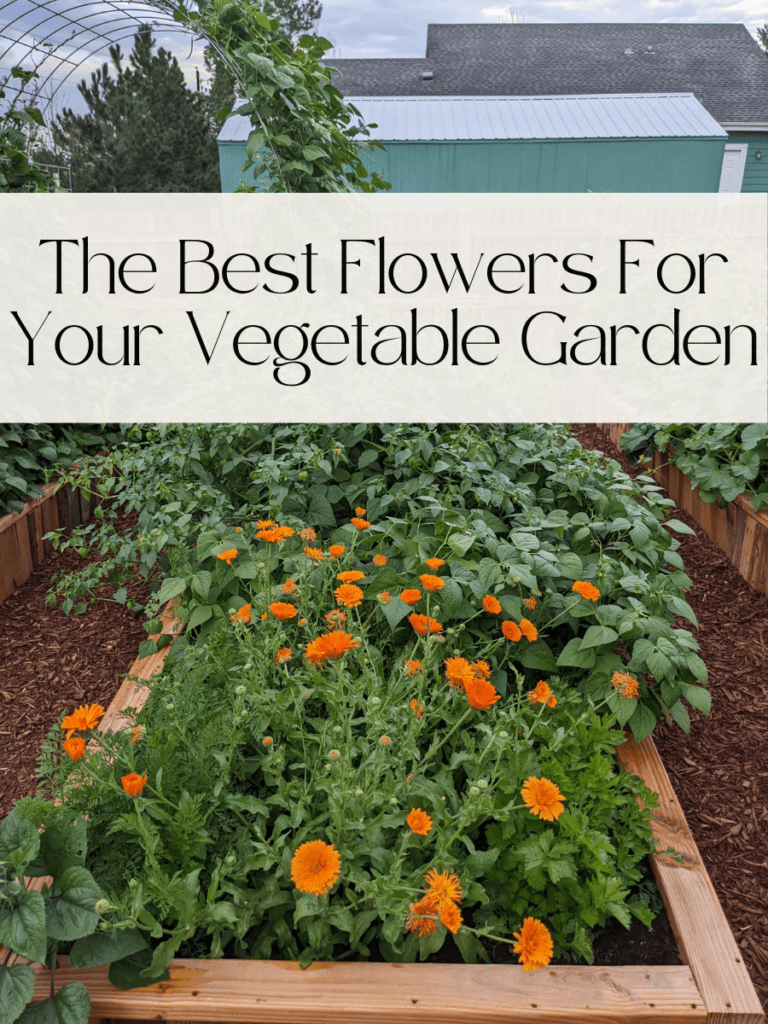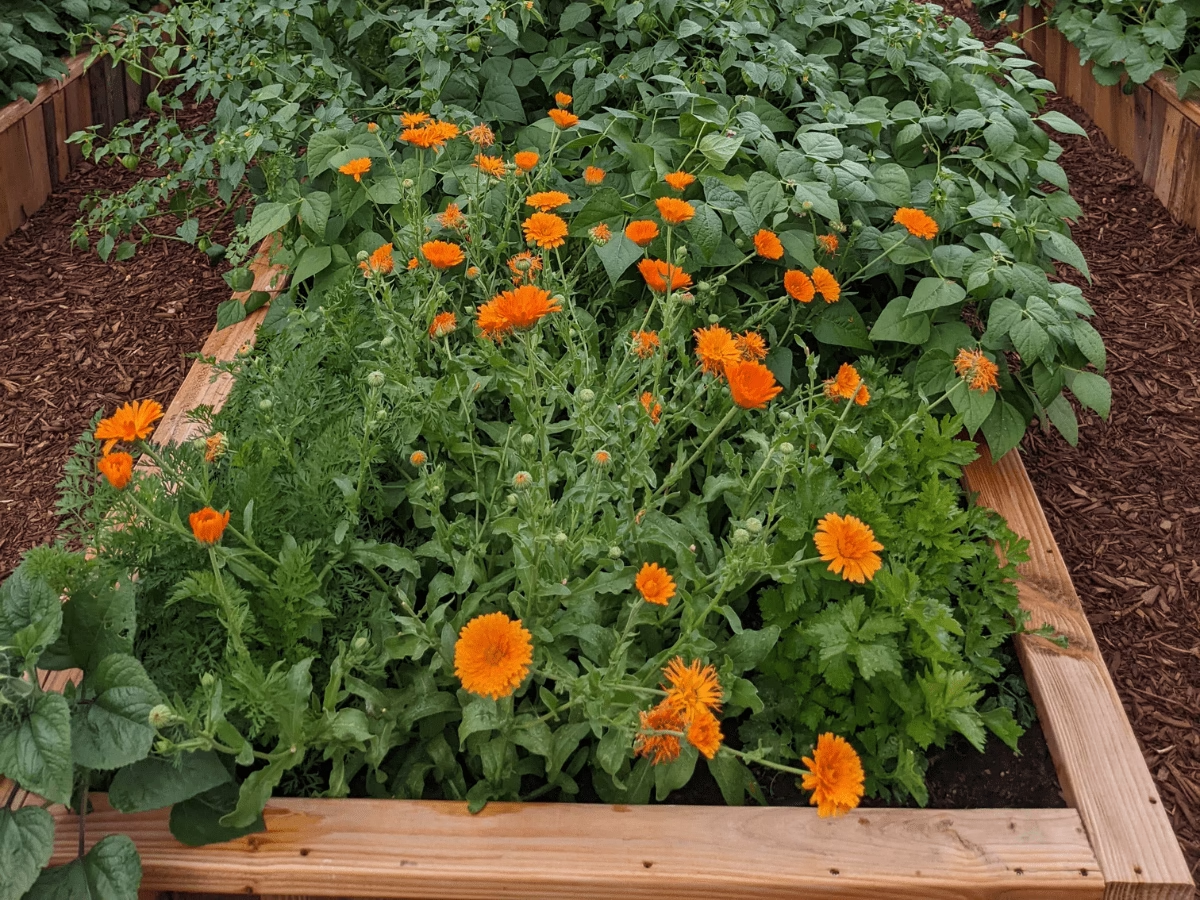Today, I will talk about the best flowers to add to your vegetable garden and why you must! I will share my coveted list of the best flowers and how to use them in your garden effectively.
To say I love flowers is an understatement! They are one of my favorite things in the world. When I planted my first garden, I filled it with lots of flowers. I found out almost by accident that flowers are great at attracting pollinators to my garden and enticing the bugs to eat them instead of my tomatoes!

This post is all about the best flowers for your vegetable garden.
This post contains affiliate links. When I suggest products, and you purchase something using my link, I will receive a commission at no extra cost to you.
Benefits of Adding Flowers to a Vegetable Garden
There are so many benefits to adding flowers to your vegetable garden! Flowers will attract pollinators to your garden to pollinate all of your lovely vegetable plants so you will get better yields. Having more colorful flowers will attract in more bees and butterflies.
Another benefit of adding flowers to your garden is that the flowers will attract beneficial insects that will eat bugs that you don’t want in your garden. Those beneficial insects could be ladybugs, green lacewings, praying mantis, spiders, soldier beetles, and hoverflies. Many beneficial insects show up in the garden before other insects do, be sure to plant early blooming flowers such as alyssum. Beneficial insects are also attracted to compound blossoms such as yarrow and queen annes lace.
Companion planting with flowers will result in healthier vegetables. The flowers add variety to the soil and use different nutrients from it. Having the same plant all in one spot, especially year after year, will deplete your soil, and that, in turn, will result in fewer healthy plants.
Adding flowers to your garden will make it look more appealing and create a more enjoyable space. The garden that does well is the garden that you spend time in. Make your garden a place that you want to be. When you are spending more time in your garden you will notice when things need to be watered, a pest needs to be taken care of or a row needs to be weeded.
Top Flowers for Vegetable Gardens and Their Benefits
Marigolds:
This easy-to-grow flower is wonderful at repelling nematodes and earwigs. I like to plant marigolds amongst my lettuces and at the ends of my rows.

Nasturtiums:
Nasturtiums trap aphids and other pesky pests. I like to plant nasturtiums under my tomatoes and around my bean plants. The pests tend to attack the nasturtiums instead of my other plants. Their leaves and flowers are also edible.

Calendula (Pot Marigold):
Attracts pollinators and deters pests. They reseed themselves easily, so keep that in mind when planting them. Calendula is also used in many body care items, like soap, lotions, and body butter.

Sunflowers:
Sunflowers attract beneficial insects. They also grow tall, so you can use their shade for tender plants.

Zinnias:
Zinnias are another easy-to-grow flower that attracts beneficial insects to the garden. They are a cut-and-come-again flower, meaning that if you cut a bunch for a bouquet the same plant will grow new flowers for you and the insects to enjoy.

Lavender:
Lavender smells wonderful to us and the bees but not so great to garden pests. Plant lavender around the perimeter of your garden to attract the bees and beneficial insects and to repel the pests.

Cosmos:
Cosmos draws in beneficial predatory insects such as lacewings, hoverflies, and parasitic wasps. They also attract beneficial insects such as butterflies and bees. Cosmos are quite tall. Keep that in mind when you are planning your garden so they don’t shade out other plants.

Alyssum:
Alyssum attracts hoverflies which eat aphids. Alyssum is an early bloomer, they are great in the spring to provide nectar for the beneficial insects before other flowers have blooms.

Yarrow:
Attracts beneficial predatory insects like lacewings and parasitic wasps with its cluster blooms.

Tips for Planting Flowers in a Vegetable Garden
Strategic placement in the garden is key to maximizing the benefits of flowers. For example, plant marigolds around the perimeter of your garden to deter pests and protect your vegetables. Nasturtiums do best under tomatoes or climbing bean plants, where they can act as a trap crop for aphids.
Companion planting is another great strategy. Pair flowers and vegetables that complement each other, such as zinnias near squash to attract pollinators, or lavender alongside cabbage to repel harmful insects. Consider bloom times and stagger your plantings to ensure flowers are available throughout the growing season.
When choosing flowers, think about your climate and the size of your garden. If you have a smaller space, opt for compact flowers like alyssum. For larger gardens, sunflowers can serve as a beautiful backdrop while providing shade for tender plants. Always check the growing requirements of each flower to ensure they thrive in your specific conditions.
Common Mistakes to Avoid
Avoid overcrowding your garden with flowers. While flowers are beneficial, too many can compete with your vegetables for sunlight, water, and nutrients. Be mindful of spacing to give every plant room to grow.
Choosing invasive or high-maintenance flowers is another common mistake. Flowers like morning glories can quickly take over if not controlled, while others may require more care than you’re ready to provide. Stick with hardy, low-maintenance options that are easy to manage.
Finally, pay attention to bloom times and spacing requirements. If all your flowers bloom at once, you might miss out on attracting beneficial insects later in the season. Stagger bloom times and keep taller flowers like cosmos or sunflowers from overshadowing smaller plants.
FAQ Section
Which flowers attract the most pollinators to my vegetable garden? Flowers like sunflowers, zinnias, and alyssum are excellent at attracting bees, butterflies, and other pollinators.
What flowers keep pests away from vegetables? Marigolds, nasturtiums, and lavender are great for repelling pests like nematodes, aphids, and cabbage moths.
Can I plant flowers and vegetables together without harming vegetable growth? Absolutely! Companion planting can actually improve vegetable growth by deterring pests and enhancing pollination.
Are there specific flowers that work best for tomatoes, cucumbers, or peppers? Yes! Nasturtiums work well with tomatoes, sunflowers can provide shade for cucumbers, and marigolds are excellent companions for peppers.
How do I prevent flowers from overtaking my vegetable garden? Strategic placement and regular maintenance, such as deadheading and pruning, can keep flowers from spreading too much.
When should I plant flowers in a vegetable garden—before or after the vegetables? Plant flowers early to establish a healthy environment for beneficial insects, but you can also stagger plantings to align with your vegetable growth.
Can I use edible flowers in my vegetable garden? If so, which ones? Yes! Nasturtiums, calendula, and lavender are not only beautiful but also edible. They can add flavor and color to your meals.
How do I maintain a balance between flowers and vegetables in a small garden? Focus on multi-functional flowers like nasturtiums and marigolds that provide pest control and attract pollinators without taking up too much space.
Conclusion
Adding flowers to your vegetable garden is not just about aesthetics—it’s about creating a thriving, balanced ecosystem that supports healthy vegetable growth. From attracting pollinators to deterring pests, flowers play an essential role in the success of your garden.
Experiment with different flower and vegetable combinations, and don’t be afraid to get creative. Your garden is a reflection of your unique style and needs. I’d love to hear about your favorite flower and vegetable pairings—share them in the comments below and inspire others to do the same!





Leave a Reply